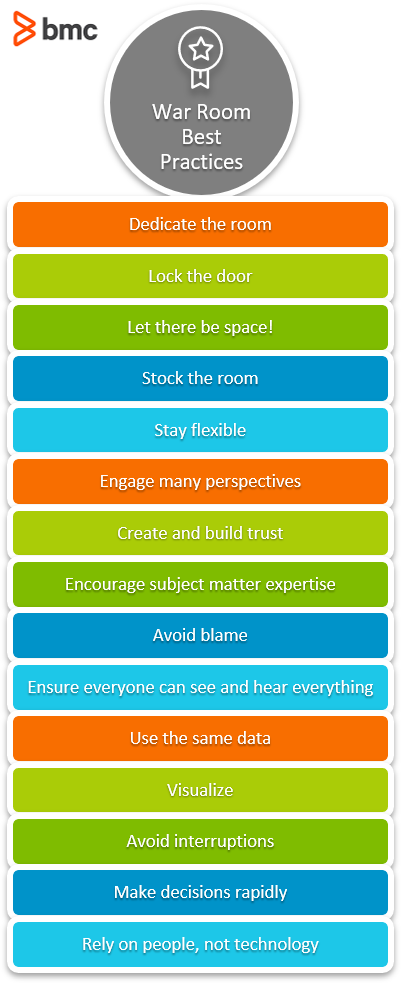The term “war room” seems to pair perfectly with end-of-the-world movies. Picture the president, sitting in a bunker-like room, surrounded by aides and Cabinet members who are providing up-to-the-minute details on the given world threat. The president must make the right decision, with no time to spare.
For most companies, this war room might seem a bit out of touch. Still, many companies deploy war rooms to solve specific problems, and IT is no exception. In this article, we’ll define the business use and benefits of an IT war room, help you determine whether a war room is for you, and provide war room best practices.
(This tutorial is part of our IT Leadership & Best Practices Guide. Use the right-hand menu to navigate.)
What is an IT war room?
Unlike a traditional office environment, war rooms are spaces where key people get together to solve a difficult problem. Also known as situation rooms, control rooms, or command centers, war rooms should always have the goal of solving a difficult or specific problem via clear communication and improved workflows.
- Improving project communication
- Solving one or more problems
- Mitigating risk
- Updating everyone’s status
IT war rooms, specifically, often aim to pinpoint a tech problem’s root cause. For example, a war room with an IT focus might have goals like how to solve slowdowns or outages, improve network inefficiencies, or contribute to a development project. IT war rooms can be particularly useful in agile environments, where you may need inter-scrum communication.
So, who should be involved in a war room? It’s essential to bring together both subject matter experts and key stakeholders, like project decision makers and even executives.
War rooms vs meetings
War rooms and meetings aren’t the same. Unlike a normal meeting, a war room should mix people together who might not otherwise collaborate. War rooms also last longer; meetings might go 30 minutes or one hour. The best war rooms are located in a dedicated space for one or more full days or for a few hours over a week.
Most importantly, war rooms should feel different from meetings. Whereas a meeting might have one or two leaders sharing specific information, war rooms should encourage all attendees to speak up, move around, ask questions, and seek solutions. Generally, a war room feels more casual but also more engaging than a typical meeting.
Benefits of an IT war room
Proponents of IT war rooms tout many benefits. Perhaps the biggest benefit is the increased productivity. Scientists at the University of Michigan compared groups of software developers working in war rooms versus employees in a more traditional office environment. Their research illustrated an increase in productivity—some were four times more productive than their solo counterparts. Another bonus? The war room workers liked their new environment better than they initially anticipated.
That productivity increase may be attributable to several benefits of working in a war room:
- Communicate quickly and directly. Verbal communication is quicker than emails or DMs.
- Promote teamwork. Research shows that positive feelings around your team and collaboration results in increased commitment, responsibility, and accountability.
- Simplify transitions. Whether bringing in new employees or introducing major changes to your project, a war room offers a single stream of information that smooths the transition and ensures all players have correct, up-to-date information.
- Resolve issues promptly. The goal for IT war rooms is to reach decisions quickly—if you can’t or don’t, table them for the next session.
- Easily document lessons learned. This information can speed up or improve future projects.
Even if your IT war room doesn’t realize every single one of these benefits, collaborative face-to-face time among employees is valuable, especially in today’s remote workforce.
Is an IT war room always worth it?
If you’ve ever left a war room with warm, fuzzy feelings about your colleagues but without hard decisions and actionable solutions, that war room was not successful. Like any project management approach, IT war rooms aren’t always all they’re cracked up to be. In fact, some IT professionals believe that companies can overuse war rooms, which results in inefficiencies—exactly what the war room is meant to fix.
A variety of factors can make it difficult to solve IT issues: hybrid environments, multi-vendor deployments, and growing complexity and scale within enterprise infrastructure. Plus, companies still require control and security similar to on-premises infrastructure, and many departments are siloed even in terms of their technology. This decentralized technology approach may not befit a traditional war room.
If IT war rooms are meant to pinpoint a tech problem’s root cause, such decentralized technology makes it difficult for two main reasons:
- Tech problems often have many causes, not a single cause.
- The root cause of a problem is often completely unrelated to the problem itself.
In these cases, a war room results not in a quick solve but in wasted time, money, and resources. A war room that creates more problems—blamed employees, mismanaged time, sunk costs—is no war room at all.
Is an IT war room for you?
Do you need an IT war room? Consider these factors when determining if a war room is the right fit for your problem.
- The size, scale, and importance of a problem or project
- The likelihood that a complicated problem has a single solution
- The feeling that you could be doing more with your situation, but you don’t know how
- The competition is closing in and you must retain your competitive edge

IT war room best practices
Whether you’re convinced your company or project needs a war room or you’re looking to freshen up your worn-out war room ways, here are some best practices for creating a war room.
First, there are best practices on how to setup your war room:
- Dedicate the room. Do everything you can to make that war room specific to that given project. Don’t share it with normal meeting or conference space. You may even rent an off-site location to underscore your particular focus.
- Lock the door. The war room is for working on one single project only. Locking the door makes sure non-related employees aren’t looking for someone and prevents assistants from stealing executives away for something else. (Of course, war room attendees can leave whenever they need.)
- Let there be space. War rooms should have plenty of workable space. Walls and windows become makeshift displays for post-its, charts, and projections, and whiteboards and tables facilitate visual and collaborative learning.
- Stock the room. Have all the supplies you need: whiteboards and working markers in a variety of colors, post-its, extra notebooks and pens, and even snacks and refreshments. Anything that might prevent an attendee from rushing off in search of an item.
- Stay flexible. Choose chairs and tables on wheels instead of heavy conference tables and couches. This encourages attendees to break into groups and facilitates new conversations and collaborations–which result in new ways of thinking.
Once you’ve optimized your war room setup, use these best practices to establish the right protocol and attitudes for everyone inside the war room:
- Engage a variety of perspectives. Even if you’re working on an IT problem, you may be surprised at the unique perspectives that some seemingly distant employee—sales, finance, marketing—may bring to the problem. (This also breaks down silos common to most companies.)
- Create and build trust. Bringing together different business units might feel contentious. It shouldn’t. You all have a single shared goal for the war room. No matter your different backgrounds, you’re all there to solve the same problem. Stating this upfront when introducing everyone, then reiterating it through talk and nonverbal communication helps build trust among the attendees.
- Encourage subject matter expertise. All attendees are there to contribute to the problem and have been chosen for their unique perspectives and expertise. Encourage this by engaging people who may not be talking as much.
- Avoid blaming. You are looking to solve a problem, not create new ones. Acknowledge when something didn’t work, but stick to the facts, not to who may have caused the problem. If an attendee heads plays the blame game, quickly put an end to it and reroute the conversation.
- Make sure everyone can see and hear. At times, one person will lead the war room in describing the problem or summarizing data or solutions. Ensure all attendees can see and hear this information to create accountability and equality among the attendees. (If you do break into smaller groups, this is less necessary.)
- Use the same data. Streamline the data and metrics you rely on, so that all business units can understand the information. This ensures that everyone is coming from the same place.
- Visualize. Remember that everyone learns differently—some attendees may be verbal learners, relying on stories, but other attendees might need visuals of data, budgets, and timelines. Diversifying how you show and brainstorm the problem promotes creativity and new approaches.
- Avoid interruptions. Each interruption is another step away from a solution, so minimize interruptions as much as possible.
- Make decisions rapidly. Once data and perspectives are shared, make decisions quickly. If you can’t, there is some hold up that may require more time or information, so table that for next time and move to the next topic.
- Rely on people, not technology. Always remember that technology is the tool, but your people together are the solution.
Cutting edge AIOps technologies like AI and machine learning might offer a solution to failed IT war rooms. Tools like real-time infrastructure monitoring and automation can go hand-in-hand with what us humans excel at: providing accurate insight of more sophisticated situations. With customized, up-to-date tools and the smarts of your best colleagues, IT war rooms can go back to what makes them successful—resolving infrastructure slowdowns, outages, and other problems in no time at all.
Related reading
- BMC Service Management Blog
- BMC Business of IT Blog
- Tiger Teams: How To Solve Critical Problems
- What Is An IT Steering Committee?
- Types of IT Teams
- IT Best Practices







